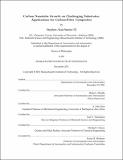Carbon nanotube growth on challenging substrates : applications for carbon-fiber composites
Author(s)
Steiner, Stephen Alan, III
DownloadFull printable version (15.81Mb)
Other Contributors
Massachusetts Institute of Technology. Dept. of Aeronautics and Astronautics.
Advisor
Brian L. Wardle.
Terms of use
Metadata
Show full item recordAbstract
Nanoengineered hierarchal fiber architectures are promising approaches towards improving the inter- and intralaminar mechanical properties (e.g., toughness and strength) and non-mechanical properties of advanced fiber-reinforced composites such as graphite/epoxy. One fiber architecture of particular interest is carbon fiber coated with radially-aligned arrays of carbon nanotubes (CNTs), which can enable through-thickness and interply matrix reinforcement of carbon-fiber-reinforced composites while simultaneously providing additional multifunctional benefits such as electrical and thermal conductivity enhancement. Growth of CNTs on carbon fibers can be achieved by chemical vapor deposition (CVD) techniques, however previous processes for doing so have resulted in a significant reduction in the tensile strength and stiffness of the carbon fibers. This thesis aims to develop an understanding of catalyst-substrate and CVD environment-substrate interactions relevant to maintaining fiber mechanical properties in the growth of CNTs on carbon fibers by CVD and to use this understanding to develop practical approaches for growing CNTs on carbon fibers that simultaneously preserve fiber properties. Novel oxide-based catalysts are demonstrated for the first time to be effective for both CNT growth and graphitization of amorphous carbon and are characterized using in situ metrology. These catalysts show promise for use on substrates that exhibit sensitivity to conventional metal catalysts (such as carbon fibers). New CVD processing techniques based on materials properties unique to this class of catalysts are presented and explored. Coatings for enabling growth of aligned CNTs on carbon fibers, coatings for improving adhesion of materials to carbon fibers, and coatings for facilitating low-temperature growth of CNTs on carbon fibers are developed. The mechanochemical responses of carbon fibers to high-temperature processing, exposure to CVD gases relevant for CNT growth, and in situ tensioning during CVD growth at high temperatures are investigated. Methods for growing CNTs on carbon fibers that enable aligned CNT morphologies and that preserve fiber properties are presented. A new system for optimizing CNT growth on carbon fibers with special considerations for oxide-based catalysts is described. Finally, recommendations for manufacturing hierarchal carbon fibers for composites in an industrially practical way are made.
Description
Thesis (Ph. D.)--Massachusetts Institute of Technology, Dept. of Aeronautics and Astronautics, February 2012. This electronic version was submitted by the student author. The certified thesis is available in the Institute Archives and Special Collections. "December 2011." Cataloged from student submitted PDF version of thesis. Includes bibliographical references (p. 305-315).
Date issued
2012Department
Massachusetts Institute of Technology. Department of Aeronautics and AstronauticsPublisher
Massachusetts Institute of Technology
Keywords
Aeronautics and Astronautics.